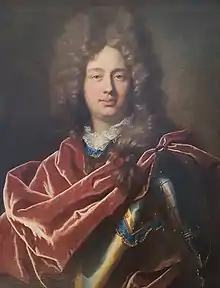Maximilian Ulrich von Kaunitz
Count Maximilian Ulrich von Kaunitz-Rietberg (Czech: Maxmilián Oldřich z Kounic-Rietbergu; March 27, 1679 in Vienna – September 10, 1746 in Brno) was an Austrian diplomat, politician and also a Governor of Moravia from 1720 to 1746.[1] His older brother was Franz Karl von Kaunitz (1676–1717), a canon in Olomouc (German: Olmütz) and Bishop of Ljubljana (Laibach).

Life
He was born in Vienna to a wealthy Moravian noble family. His parents were Count Dominik Andreas I von Kaunitz, baron of Šlapanice and Countess Marie Eleonore von Sternberg (daughter of Count Adolph of Sternberg), the Supreme Burgrave of Bohemia). On 6 August 1699, he groomed a German countess, Maria Franziska von Ostrfriesland, Countess von Rietberg (daughter of Ferdinand Maximilian von Ostfriesland, Count von Rietberg and his wife, the Countess Johanette Elisabeth Franziska von Manderscheid-Blankenheim). At the time of marriage, Kaunitz had twenty years, while his wife had just thirteen. With this important marriage, her family came to the County of Rietberg, and then taking the name Kaunitz-Rietberg. The marriage produced 11 children (6 sons, 5 daughters) including:
- Maria Antonia Josepha von Kaunitz-Rietberg (June 15, 1708 – July 14, 1778). In 1738 married Count Hans Adam von Questenberg, Imperial Chamberlain
- Wenzel Anton, Prince of Kaunitz-Rietberg (February 2, 1711 – June 27, 1794), Prince of the Holy Roman Empire from 1764, State Chancellor. On May 6, 1736 married Countess Maria Ernestine von Starhemberg[2]
Career
He inherited the County of Rietberg at an early age, until they reach the age of 18 remained under protection. Waged the civil service career in Habsburg Monarchy, in 1706 managed to be appointed Imperial Chamberlain, and by 1721 was the Imperial Ambassador to the papal court in Rome.
Since 1718 he was awarded the title of count, while continuing to reside with his family mainly in Vienna, ruling the County of Rietberg by proxy. From 1720 until his death, he was governor general of the Moravia where, among other things, he tried to make navigable the river Morava (March). He created an academy in Olomouc Corporate and built a road to quick connection between Brno and Olomouc. Also, he enforced partial reforms of the provincial administration.[3] It was then the imperial emissary in the conclave of 1724 that saw the election of Pope Benedict XIII.
For his services was honoured with the Order of the Golden Fleece in 1744.
References
- This article is based in part on material from the Czech Wikipedia.
- Kolektiv autorů: Brněnské paláce. Stavby duchovní a světské aristokracie v raném novověku; Brno, 2005 ISBN 80-7364-016-3
- Kroupa, Jiří: Alchymie štěstí; Brno, 2006 s. 87 ISBN 80-7366-063-6
- Kolektiv autorů: Brněnské paláce. Stavby duchovní a světské aristokracie v raném novověku; Brno, 2005 ISBN 80-7364-016-3
Further reading
- Heribert Sturm, Biographisches Lexikon zur Geschichte der böhmischen Länder. herausgegeben im Auftrag des Collegium Carolinum (Institut). Band II, R. Oldenbourg Verlag, München 1984, ISBN 3-486-52551-4, S. 121 und 122.
- Roman von Procházka: Genealogisches Handbuch erloschener böhmischer Herrenstandsfamilien. Neustadt an der Aisch 1973, ISBN 3-7686-5002-2, S. 138: Stammfolge Kaunitz (z Kunicz, Kaunitz-Rittberg, Kaunitz-Rietberg-Questenberg)
- Alfred von Arneth: Biographie des Fürsten Kaunitz: Ein Fragment. In: AÖG. 88, 1900, S. 8–10.
- Grete Klingenstein: Der Aufstieg des Hauses Kaunitz. Studien und Herkunft und Bildung des Staatskanzlers Wenzel Anton von Kaunitz. Göttingen 1975, ISBN 3-525-35906-3.
| Political offices | ||
|---|---|---|
| Preceded by Dominik Andreas I von Kaunitz |
Baron of Šlapanice 1705–1746 |
Succeeded by Wenzel Anton, Prince of Kaunitz-Rietberg |